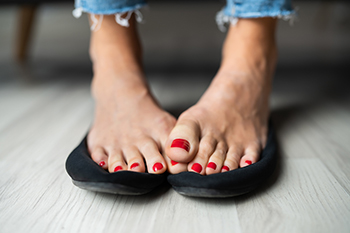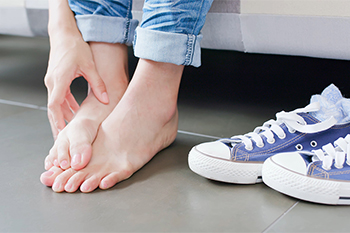Items filtered by date: December 2022
A Ruptured Achilles Tendon

Achilles tendonitis is a condition that can occur due to tears in the tendon from overuse. A ruptured Achilles tendon is an injury that happens when a sudden strain overwhelms the Achilles tendon. With a rupture, one will feel sudden and intense pain as well as a possible popping noise. Furthermore, there can be burning, swelling, and stiffness in the area. Sometimes it is hard to distinguish whether the Achilles tendon is ruptured, or if the pain is a result of a pulled muscle. However, if the pain is intense and does not go away or if there is greater than average stiffness in the area it is likely a rupture. It may also be a rupture when one does not pass the Thompson test, where the soleus complex is manipulated. This kind of injury does not heal quickly. One needs to rest and participate in physical therapy for proper healing. Because many of these symptoms can overlap with other afflictions, it is a good idea to make an appointment with a podiatrist for a proper diagnosis and treatment plan.
Achilles tendon injuries need immediate attention to avoid future complications. If you have any concerns, contact one of our podiatrists of Cascade Foot Clinic. Our doctors can provide the care you need to keep you pain-free and on your feet.
What Is the Achilles Tendon?
The Achilles tendon is a tendon that connects the lower leg muscles and calf to the heel of the foot. It is the strongest tendon in the human body and is essential for making movement possible. Because this tendon is such an integral part of the body, any injuries to it can create immense difficulties and should immediately be presented to a doctor.
What Are the Symptoms of an Achilles Tendon Injury?
There are various types of injuries that can affect the Achilles tendon. The two most common injuries are Achilles tendinitis and ruptures of the tendon.
Achilles Tendinitis Symptoms
- Inflammation
- Dull to severe pain
- Increased blood flow to the tendon
- Thickening of the tendon
Rupture Symptoms
- Extreme pain and swelling in the foot
- Total immobility
Treatment and Prevention
Achilles tendon injuries are diagnosed by a thorough physical evaluation, which can include an MRI. Treatment involves rest, physical therapy, and in some cases, surgery. However, various preventative measures can be taken to avoid these injuries, such as:
- Thorough stretching of the tendon before and after exercise
- Strengthening exercises like calf raises, squats, leg curls, leg extensions, leg raises, lunges, and leg presses
If you have any questions please feel free to contact our offices located in Bend and Redmond, OR . We offer the newest diagnostic tools and technology to treat your foot and ankle needs.
Gout Pain Can Be Managed
Dealing With Sweaty Feet

Sweaty feet can be a temporary problem caused by having your feet enclosed in shoes and socks all day, or from high temperatures. But if having sweaty feet is an everyday occurrence, the chances are that you have a condition known as hyperhidrosis. This condition is thought to be genetic in nature. Some people are born with overactive sweat glands, and the moisture produced goes well beyond sweating from hot weather, exercising, or stress. Several underlying health conditions and certain foods may also cause hyperhidrosis. In some cases of hyperhidrosis, bacteria forms around the feet, causing them to emit a foul odor. It is a good idea to use antibacterial soap regularly to keep the feet clean and healthy. Wearing moisture-wicking socks or open-toed shoes or sandals is a good way to keep your feet dry. A podiatrist can offer more advanced treatment options, including several prescribed antiperspirant medications. In extreme cases, surgery to block the nerve passageway that tells the feet to sweat can be performed. For more information, please contact a podiatrist.
If you are suffering from hyperhidrosis contact one of our podiatrists of Cascade Foot Clinic. Our doctors can provide the care you need to attend to all of your foot and ankle needs.
Hyperhidrosis of the Feet
Hyperhidrosis is a rare disorder that can cause people to have excessive sweating of their feet. This can usually occur all on its own without rigorous activity involved. People who suffer from hyperhidrosis may also experience sweaty palms.
Although it is said that sweating is a healthy process meant to cool down the body temperature and to maintain a proper internal temperature, hyperhidrosis may prove to be a huge hindrance on a person’s everyday life.
Plantar hyperhidrosis is considered to be the main form of hyperhidrosis. Secondary hyperhidrosis can refer to sweating that occurs in areas other than the feet or hands and armpits. Often this may be a sign of it being related to another medical condition such as menopause, hyperthyroidism and even Parkinson’s disease.
In order to alleviate this condition, it is important to see your doctor so that they may prescribe the necessary medications so that you can begin to live a normal life again. If this is left untreated, it is said that it will persist throughout an individual’s life.
A last resort approach would be surgery, but it is best to speak with your doctor to find out what may be the best treatment for you.
If you have any questions please feel free to contact our offices located in Bend and Redmond, OR . We offer the newest diagnostic and treatment technologies for all your foot and ankle needs.
Athlete’s Foot in Teens
 Athlete’s foot is a fungal skin infection that thrives in damp, warm environments. It can cause annoying and uncomfortable redness, rashes, and flakiness between the toes and on the soles of the feet. This condition is contagious and can spread to other parts of the body or other people who encounter it. Athlete’s foot can affect people of all ages. Teens are a high-risk group because they are likely to participate in sports, walk barefoot in public places, and not be as careful about grooming their feet. Athlete’s foot usually goes away in a couple of weeks. However, treatment might be longer, especially if it becomes infected or impacts the toenails. Teens should be taught to keep their feet clean and dry, wear shoes in warm, wet public spaces, switch up which shoes are worn often to prevent moisture buildup, and change socks to ones made of material that wicks moisture away regularly. If your teen has athlete’s foot, it is suggested you take them to see a podiatrist who can treat it most effectively and efficiently.
Athlete’s foot is a fungal skin infection that thrives in damp, warm environments. It can cause annoying and uncomfortable redness, rashes, and flakiness between the toes and on the soles of the feet. This condition is contagious and can spread to other parts of the body or other people who encounter it. Athlete’s foot can affect people of all ages. Teens are a high-risk group because they are likely to participate in sports, walk barefoot in public places, and not be as careful about grooming their feet. Athlete’s foot usually goes away in a couple of weeks. However, treatment might be longer, especially if it becomes infected or impacts the toenails. Teens should be taught to keep their feet clean and dry, wear shoes in warm, wet public spaces, switch up which shoes are worn often to prevent moisture buildup, and change socks to ones made of material that wicks moisture away regularly. If your teen has athlete’s foot, it is suggested you take them to see a podiatrist who can treat it most effectively and efficiently.
Athlete’s foot is an inconvenient condition that can be easily reduced with the proper treatment. If you have any concerns about your feet and ankles, contact one of our podiatrists from Cascade Foot Clinic. Our doctors will treat your foot and ankle needs.
Athlete’s Foot: The Sole Story
Athlete's foot, also known as tinea pedis, can be an extremely contagious foot infection. It is commonly contracted in public changing areas and bathrooms, dormitory style living quarters, around locker rooms and public swimming pools, or anywhere your feet often come into contact with other people.
Solutions to Combat Athlete’s Foot
- Hydrate your feet by using lotion
- Exfoliate
- Buff off nails
- Use of anti-fungal products
- Examine your feet and visit your doctor if any suspicious blisters or cuts develop
Athlete’s foot can cause many irritating symptoms such as dry and flaking skin, itching, and redness. Some more severe symptoms can include bleeding and cracked skin, intense itching and burning, and even pain when walking. In the worst cases, Athlete’s foot can cause blistering as well. Speak to your podiatrist for a better understanding of the different causes of Athlete’s foot, as well as help in determining which treatment options are best for you.
If you have any questions please feel free to contact our offices located in Bend and Redmond, OR . We offer the newest diagnostic and treatment technologies for all your foot and ankle needs.
Foot Problems in Newborns

Foot deformities are among the most common deformities in newborns. Most of the foot problems newborns face are treated non-surgically. Such newborn deformities include clubfoot, which describes an array of foot deformities that lead a newborn’s feet to be twisted, pointed down, and inward. Approximately half of the babies with clubfoot have it on both feet and boys are more apt to have clubfoot than girls. This affliction does not cause a baby pain, but it can lead to long-term difficulties with walking. If treated with stretching exercises, casts, or surgery, a clubfoot deformity can be corrected in early childhood. If you are pregnant and expect your baby to be born with clubfoot, or you have such a newborn, it is suggested that you see a podiatrist as soon as possible for treatment to prevent any long-term impact from this condition.
Congenital foot problems require immediate attention to avoid future complications. If you have any concerns, contact one of our podiatrists of Cascade Foot Clinic. Our doctors can provide the care you need to keep you pain-free and on your feet.
Congenital foot problems are deformities affecting the feet, toes, and/or ankles that children are born with. Some of these conditions have a genetic cause while others just happen. Some specific foot ailments that children may be born with include clubfeet, polydactyly/macrodactyly, and cleft foot. There are several other foot anomalies that can occur congenitally. What all of these conditions have in common is that a child may experience difficulty walking or performing everyday activities, as well as trouble finding footwear that fits their foot deformity. Some of these conditions are more serious than others. Consulting with a podiatrist as early as possible will help in properly diagnosing a child’s foot condition while getting the necessary treatment underway.
What are Causes of Congenital Foot Problem?
A congenital foot problem is one that happens to a child at birth. These conditions can be caused by a genetic predisposition, developmental or positional abnormalities during gestation, or with no known cause.
What are Symptoms of Congenital Foot Problems?
Symptoms vary by the congenital condition. Symptoms may consist of the following:
- Clubfoot, where tendons are shortened, bones are shaped differently, and the Achilles tendon is tight, causing the foot to point in and down. It is also possible for the soles of the feet to face each other.
- Polydactyly, which usually consists of a nubbin or small lump of tissue without a bone, a toe that is partially formed but has no joints, or an extra toe.
- Vertical talus, where the talus bone forms in the wrong position causing other bones in the foot to line up improperly, the front of the foot to point up, and the bottom of the foot to stiffen, with no arch, and to curve out.
- Tarsal coalition, when there is an abnormal connection of two or more bones in the foot leading to severe, rigid flatfoot.
- Cleft foot, where there are missing toes, a V-shaped cleft, and other anatomical differences.
- Macrodactyly, when the toes are abnormally large due to overgrowth of the underlying bone or soft tissue.
Treatment and Prevention
While there is nothing one can do to prevent congenital foot problems, raising awareness and receiving neonatal screenings are important. Early detection by taking your child to a podiatrist leads to the best outcome possible.
If you have any questions please feel free to contact our offices located in Bend and Redmond, OR . We offer the newest diagnostic tools and technology to treat your foot and ankle needs.

